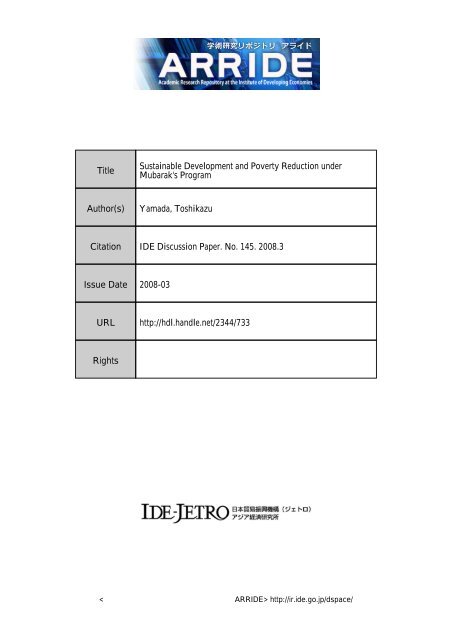Title Sustainable Development and Poverty Reduction under ...
Title Sustainable Development and Poverty Reduction under ...
Title Sustainable Development and Poverty Reduction under ...
- No tags were found...
Create successful ePaper yourself
Turn your PDF publications into a flip-book with our unique Google optimized e-Paper software.
The Institute of Developing Economies (IDE) is a semigovernmental,nonpartisan, nonprofit research institute, founded in 1958. The Institutemerged with the Japan External Trade Organization (JETRO) on July 1, 1998.The Institute conducts basic <strong>and</strong> comprehensive studies on economic <strong>and</strong>related affairs in all developing countries <strong>and</strong> regions, including Asia, theMiddle East, Africa, Latin America, Oceania, <strong>and</strong> Eastern Europe.The views expressed in this publication are those of the author(s). Publication doesnot imply endorsement by the Institute of Developing Economies of any of the viewsexpressed within.INSTITUTE OF DEVELOPING ECONOMIES (IDE), JETRO3-2-2, WAKABA, MIHAMA-KU, CHIBA-SHICHIBA 261-8545, JAPAN©2008 by Institute of Developing Economies, JETRO
<strong>Sustainable</strong> <strong>Development</strong> <strong>and</strong> <strong>Poverty</strong> <strong>Reduction</strong> <strong>under</strong> Mubarak’s Program1. IntroductionThis paper describes <strong>and</strong> analyzes the Major features of economic development <strong>and</strong>poverty in Egypt during its transition to a market economy. It focuses on the changes in thesituation of poverty <strong>and</strong> economic policies or adjustment policies as remedires by thegovernment of Egypt <strong>and</strong> the ruling National Democratic Party (NDP).<strong>Sustainable</strong> development <strong>and</strong> poverty rduction is the core of the President Mubarak’selection campaign for his fifth term for the presidency.However, this paper does not cover the full range of the topics; rather it attempts toexplain the obstacles encountered by the Egyptian economy in terms of adjustments <strong>and</strong>general economic arguments on poverty, with the aim to give the general reader an<strong>under</strong>st<strong>and</strong>ing of the special features of poverty in Egypt.Finally, we refer to the necessity for enhanced accountability <strong>and</strong> transparency in thedemocratized <strong>and</strong> decentralized society to accomplish the goal.2. Obstacles <strong>and</strong> AdjustmentsEgypt’s economic development has been affected by several internal <strong>and</strong> external events,which have led to changes in the regime, cabinet <strong>and</strong> policy frameworks, as well as byadjustment policies. Though the July Revolution of 1952 allowed Egypt to achieveindependence from foreign dominance in terms of economic resources <strong>and</strong> politics, the1
government’s new aspiration for social justice, followed by nationalization <strong>and</strong> thesocialistic regime, came at the cost of some inefficiency in resource allocation <strong>and</strong>X-efficiency. These structural problems or policy-induced distortions became obstacles forsubsequent development.Before the July Revolution, poverty, illiteracy, <strong>and</strong> disease were an unholy trinity forEgypt, <strong>and</strong> solution of these problems were the main political, economic <strong>and</strong> socialobjectives of the government. The first l<strong>and</strong> reform was <strong>under</strong>taken soon after therevolution, <strong>and</strong> the government began to build the administrative organs for comprehensivecentral planning. Liberal trade <strong>and</strong> investment policies were rejected <strong>under</strong> the unfavorableclimate with Western countries following the nationalization of the Suez Canal Company in1956. The government formulated <strong>and</strong> implemented long-term development plans in theframework of the socialistic regime, laying special importance on social justice in the fieldof employment in the government <strong>and</strong> public sectors, the adjustment of minimum wages,the procurement of fundamental items based on subsidies, the expansion of educational <strong>and</strong>health services, <strong>and</strong> innovations in various economic <strong>and</strong> social dimensions.However, despite some early success in the 1960s, this experiment ultimately failed,partly due to the June War of 1967 <strong>and</strong> partly due to the inexperience of the institutions 1 .In the early 1970s, the Sadat regime began to open Egypt, politically <strong>and</strong> economically,to Arab <strong>and</strong> Western counterparts. The government shifted its strategy from publicsector-led to private sector-led development, from a closed to open economy (Infitah, theOpen Door Policy), <strong>and</strong> from an inward to outward orientation. The major polices were to1 For an evaluation of experiments in socialism <strong>and</strong> central planning, please see Hansen2
encourage an inflow of financial resources from the Arab oil-exporting countries <strong>and</strong> theintroduction of new production <strong>and</strong> management technologies from the West in order toincrease production factors <strong>and</strong> improve the technology coefficient. In addition toproviding wider management autonomy to the existing public sector <strong>and</strong> new private sector,the government facilitated the procurement of foreign currencies by establishing a parallelmarket for the importation of raw materials <strong>and</strong> investment goods 2 . These incentives failedto bear fruits, as this period saw a sudden shortage of foreign currencies following thecontinuous expansion of consumption in the wake of the October War of 1973, thereconstruction of infrastructure damaged during the war, the building of new infrastructure,<strong>and</strong> military debts contracted with the United States at high interest rates varying from 12to 14% per annum 3 .In summary, the policies were always halfhearted 4 . A substantial transition to adecentralized <strong>and</strong> market-oriented economy was not achieved.During the latter half of the 1970s, the IMF recommended economic reforms to restorean internal <strong>and</strong> external equilibrium. The main reform policies were exchange rateunification in the place of a multiple exchange rate system of the Egyptian pound <strong>and</strong>[1969], Al-Gritly [1977), Abdel-Khalek [1982], etc.2 The parallel market was intended primarily to attract workers’ remittances, but also toencourage tourism <strong>and</strong> certain exports.3 The Egyptian governments repeated negotiations with the US governments deliberatelyto reduce the interest rates on the military debts to lower rates prevailing in theinternational markets after “the strong dollar” period. Details of the negotiations <strong>and</strong>compromises from the US governments were explained in several articles by Mervatal-Hasry <strong>and</strong> others in Al-Iqtisadi.4 Egyptian officials <strong>and</strong> experts, to some extent, supported the structuralist’s views oninflation <strong>and</strong> the undesirable effects of adjustment policies, especially, interest rate policyon price level <strong>and</strong> growth. See Abdel-Khalek <strong>and</strong> Korayem[1995]<strong>and</strong> several argumentsby Kirkpatrick <strong>and</strong> Onis [1985], Kirkpatrick <strong>and</strong> Nixon [1987], <strong>and</strong> Porter <strong>and</strong> Ranney3
dem<strong>and</strong> management. However, a well-designed <strong>and</strong> decisive reform budget includingreductions in subsidies was rejected following the food riots in 1977. Clearly, the nationalbudget <strong>and</strong> balance of payments were <strong>under</strong> pressure from the servicing of external debts.However, the indebtedness was not eliminated. Instead, the solutions involvedimplementing reform policies <strong>and</strong> rescheduling the debts, or in other words, deferringrepayment to the near future without any real debt relief.During the 1970s <strong>and</strong> 1980s, voluntary <strong>and</strong> forced adjustments were introduced butwithout significant results. Financial repression prevailed <strong>and</strong> inflation led to anaggravation of the economic situation <strong>and</strong> unemployment, consequently poverty (Chart 1).During this period, some troubles involving informal money dealers <strong>and</strong> IslamicInvestment Companies (IICs) emerged (Harik [1998]), leading to a freeze of the savings ofEgyptian small savers <strong>and</strong> workers abroad, eroding the net value of their savings duringinflationary period. A transformation of the illegal investment companies was successfullypromoted by Prime Minister, Ministers of the Economy, presidents of the Capital MarketAuthority, <strong>and</strong> financial <strong>and</strong> legislative experts in the latter half of 1980s 5 . The illegal <strong>and</strong>informal financial intermediaries with a moral hazard were dissolved, <strong>and</strong> their assets werereturned to small savers or investorsin phases 6 .[1982].5 See detailed comments <strong>and</strong> contributions on the negative economic <strong>and</strong> social aspects ofthe Islamic investment companies made by various specialists <strong>and</strong> scholars in al-iqtisadi,especially, Mahmoud Fahmy, Mahmoud Abdel-Fadil, Saad El-Din Ibrahim, etc.6 See an article by Editor, Essam Rifaat, in Al-Iqtisadi, December 28, 1998 on thesituation of settlements of the various Islamic investment companies. Assets of theal-Rayan <strong>and</strong> al-Sherif, among them, were detailed by interviews with the mostresponsible Minister of Justice <strong>and</strong> Prosecutor General. Meanwhile, Prime MinisterEl-Ghanzoury had already decided repayment to the investors to the al-Rayan from thestate treasury.4
This situation continued until the launching of ERSAP (Economic Reform <strong>and</strong> StructuralAdjustment Program) in the early 1990s when the international community came toacknowledge Egypt’s strategic importance on the occasion of the Gulf War in 1991. Longawaited financial liberalization <strong>and</strong> prudential policies were implemented in advance of theformal start of ERSAP at the beginning of 1991. The unification of exchange rates <strong>and</strong>liberalization of interest rates led to a rise in the inflow of remittances from workers abroad<strong>and</strong> speculative inflows. The stabilization was achieved by money supply control throughthe sterilization of inflows of foreign currencies by the issuance of treasury bills. Theinflow of financial resources <strong>and</strong> accumulation of international reserves were induced byseveral positive economic <strong>and</strong> psychological environmental changes: a reduction of bothmilitary <strong>and</strong> non-military debts, restoration of the creditworthiness of the Egyptian pound<strong>and</strong> the emergence of an image of Egypt as a stable presence in the unstable Middle East.ERSAP succeeded in stabilizing the economy through its austerity policy <strong>and</strong> de factodollar peg of the Egyptian pound, <strong>and</strong> succeeded to some extent in transforming theeconomy to a market-oriented one through trade liberalization <strong>and</strong> privatization 7 .The post stabilization experience in Egypt was harsh, involving the appreciation of theEgyptian pound <strong>and</strong> the expansion of fiscal expenditures to achieve the goal of exp<strong>and</strong>ingthe population of areas outside the Nile Valley <strong>and</strong> the creation of employment. This periodwitnessed high growth rates for domestic goods industries <strong>and</strong> import-substitutingmanufacturing industries.In addition, the economy <strong>under</strong>went internal <strong>and</strong> external shocks including the Tragedy7 See Subramanian [1997] <strong>and</strong> H<strong>and</strong>y [1998]. The IMF highly appreciated the5
of Luxor <strong>and</strong> the economic crises in East Asia <strong>and</strong> Russia in 1997 <strong>and</strong> 1998.As a result of rigidities in exports of non-oil manufacturing goods, Egypt experiencedanother dollar crisis in the aftermath of September 11, 2001. In a speech at the time,President Mubarak stated, “exports are a life <strong>and</strong> death issue.”However, this crisis was overcome by utilizing the international reserves accumulatedduring the ERSAP stage. However, before the floating of the Egyptian pound in early 2003,several adjustments were made by changing the foreign exchange regime between a hardpeg <strong>and</strong> float 8 . This stage was marked by economic stagnation <strong>and</strong> inflation. The recoveryof sustainable growth was attained thanks to a favorable external environment, including anincrease of oil export revenues <strong>and</strong> recovery of the tourism sector, which came in 2004, at afortunate time for the new government, which was implementing drastic reforms in theincome tax <strong>and</strong> import duty, working to resolve the problem of non-performing bank loans 9 ,<strong>and</strong> enacting WTO-related laws such as an anti–monopolistic activities law.In summary, the Egyptian government tried to enhance the economy through an“engineering” approach <strong>and</strong> “industrial organization” approach (Galal [2006]). However, itseems that accomplishment of accountability <strong>and</strong> transparency in the society is still on thestabilization <strong>and</strong> recovery of the economy as a success story except delayed privatization.8 See Mussa [2000] <strong>and</strong> Taylor [2005] on the exchange rate regimes <strong>and</strong> discussionsbetween the authors <strong>and</strong> participants on which is the most suitable exchange rate regimefor Egypt to adopt.9 At that time banks were suffered from the bankrupts of major borrowers who wereinfluencial on the lending policies of banks, <strong>and</strong> this hampered the financialintermediation in Egypt. See various articles in Al-Iqtisadi in 2003. It is noteworthy topoint that 250 investors received 28% of the bank loan without mortgages until the end of1998 <strong>and</strong> other related problems detrimental to management of banks (Al-Iqtisadi, May 26,2003).Several important comments were made by Salwa El-Antary of NBE on therelationship between increase in credits to private sector <strong>and</strong> increase in deposit in Egypt,as a whole (Al-Iqtisadi, June 16, 2003).6
way. It is not easy for the society to enhance democratization <strong>and</strong> decentralization ingeneral <strong>and</strong> to change the culture or belief from import substitution to export promotion orfrom import culture to export culture in particular.Finally, economic stabilization <strong>and</strong> structural adjustment since ERSAP could not achievethe sustainable growth <strong>and</strong> poverty reduction. Then, sincere reform was needed forpro-poor development.3. Situation of <strong>Poverty</strong> in EgyptHow do we define poverty <strong>and</strong> distinguish the poor from the non-poor? The aim ofmeasuring poverty is to identify vulnerable groups of individuals who are unable to attain ast<strong>and</strong>ard of living that is consistent with a social st<strong>and</strong>ard.As poverty has complex <strong>and</strong> multifaceted phenomena; the distinction differs dependingon the methodology utilized: objective or subjective measurement, absolute or comparative,<strong>and</strong> money metric or other socioeconomic measurement. First, we start by utilizing moneymetric measures despite the difficulties involved. All studies on the poverty line utilizeinformation from the Household Income <strong>and</strong> Expenditures Survey (HIES) <strong>and</strong> HouseholdBudget Survey conducted by CAPMAS, a governmental statistical agency.Since 1991, comprehensive economic reforms have been in place <strong>and</strong> sincere studieshave been carried out to examine whether the reforms would adversely affect the welfare ofthe poor. At the beginning, low growth rates continued as an austerity policy wasimplemented. Later, the economic growth rate rose to as high as 5% in 1995.7
Earlier studies on poverty in Egypt (Table 1) show that the poverty level increased from1981/82 to 1990/91 in both rural <strong>and</strong> urban areas regardless of the level of incidence ofpoverty used by the author. However, from 1990/91 to 1995/96, namely the ERSAP period,significant disagreement appeared between authors in erms of the trend <strong>and</strong> level of povertyincidence. In urban areas, poverty increased. However, in rural areas, it either increased ordecreased, depending on the study.An early study (UNDP <strong>and</strong> INP [1996]) estimated the food-based poverty line for1995/96 at LE3184 per household <strong>and</strong> LE594 per capita, <strong>and</strong> the cost of basic needs (lowerexpenditure poverty line) at LE4186 per household <strong>and</strong> LE814 per capita. According to thefurther study, the incidence of poverty increased in urban areas from 20.3% to 22.3%, <strong>and</strong>decreased in rural areas from 28.6% to 23.3% between 1991 <strong>and</strong> 1995. This contrastreflected mobility from rural areas to urban areas <strong>and</strong> worsening employmentcircumstances in urban areas. At the same time, to analyze this phenomenon, severalstudies were conducted on the effects of ERSAP on poverty. Some argued that ERSAPmight adversely affect the income distribution 10 .In addition, <strong>Poverty</strong> Assessment Surveys, 43% of the respondents reported animprovement in their living conditions, whereas 57% experienced either no change (21%),or deterioration (36%). However, only 23% of the poor replied that their living st<strong>and</strong>ardshad improved over the 1991-1996 period, as compared with more than double thatpercentage for the non-poor (50%). This analysis reveals that the burden of the ERSAP fellmore heavily on the poor (UNDP <strong>and</strong> INP [1996]). The general economic condition <strong>and</strong>10 See Korayem [1996], who concludes that ERSAP had negative impacts on employment8
employment circumstances were the main factors influencing the improvement orworsening of living st<strong>and</strong>ards. However, special conditions such as retirement, aging,disease, entrance, graduation, marriage, <strong>and</strong> divorce are important factors.As mentioned above, there are considerable differences in estimates of the poverty line,leading to changes in the incidence of poverty 11 . These differences emerge from fourtechnical problems, namely (i) economies of scale within households, (ii) consumptionpatterns in different regions, (iii) hypothetical or optimal cost of the diet of the poor, <strong>and</strong>(iv) basic needs requirements of different household members – young versus old, <strong>and</strong> maleversus female.Works done by, mainly, El-Laithy <strong>and</strong> Osman [1997] <strong>and</strong> the World Bank <strong>and</strong> the MOP,have resolved the four problems mentioned above. The measurement of poverty lines hasbeen improved by defining household specific poverty lines instead of per capita povertyline, as explained in “<strong>Poverty</strong> <strong>Reduction</strong> in Egypt- Diagnosis <strong>and</strong> Strategy” Report (WorldBank <strong>and</strong> MOP [2002a]). Starting from the definition of the food poverty line, byestimating the minimum caloric needs for individuals, <strong>and</strong> estimating the cost to obtain theminimum level of calories, necessary non-food expenditures to define the lower povertyline are assumed. This reveals differences of definitions <strong>and</strong> measurements of povertyamong the studies. Results of the decisive estimation of the household specific povertylines are shown in Table 2.As for the definition, in addition to the dichotomy between the poor <strong>and</strong> non-poor, other<strong>and</strong> prices, <strong>and</strong> poverty, consequently.11 The Egypt Human <strong>Development</strong> Report 1994 defined a poor person as one whoseincome is roughly one-third of per capita national income because of conceptual difficulties9
definitions divide the poor into three groups 12 . From 1990/91 to 1995/96, the non-poor inurban <strong>and</strong> rural areas decreased from 61% to 55% <strong>and</strong> from 60.8% to 48.8%, respectively.This implies that the increase in the number of poor <strong>and</strong> moderate poor was from 18.7% to22.5% in urban areas <strong>and</strong> from 10.6% to 26.9% in rural areas. In the year of 1995/96, theultra poor made up 7.4% of the population in all of Egypt, 7.7% in urban areas, <strong>and</strong> 7.1% inrural areas.During the period from 1995/96 to 1999/2000, the Egyptian economy recorded increasedgrowth rates of 6% per year on average. In 1999/2000, the poor population fell from 13.7million people to around 11.0 million people representing 16.7% of the entire population.This period is characterized by fiscal expansion <strong>and</strong> the appreciation of the Egyptianpound above mentioned. The appreciation of the Egyptian pound (the Dutch diseasephenomenon) benefited the tourism <strong>and</strong> the manufacturing sectors that were inwardoriented <strong>and</strong> protected from external competition. Afterwards, fiscal <strong>and</strong> monetary policesbecame inconsistent <strong>under</strong> the large government expenditures on mega-projects aiming topromote growth in the regions. In addition, internal security problems <strong>and</strong> the unfavorableexternal environment had an adverse effect on the Egyptian economy in the latter half ofthe 1990s. These external factors included the economic crises in emerging markets in EastAsia <strong>and</strong> Russia.With the instability in the Middle East caused by the aftermath of September 11, 2001in estimating poverty line.12 These are the moderate (or mild) poor, the poor, <strong>and</strong> the ultra (or extreme) poor. Theborder between the non-poor <strong>and</strong> the moderately poor is the upper poverty line. Thatbetween the moderate poor <strong>and</strong> the poor is the lower poverty line. The ultra poor live belowthe food poverty line.10
<strong>and</strong> the ensuing War in Afghanistan, the Egyptian economy started to shrink, recording lowannual growth rates of around 3%. These factors led to a new dollar crisis <strong>and</strong> finally to theflotation of the Egyptian pound in early 2003. The floating, in turn, triggered an increase ofprice levels, <strong>and</strong> the CPI rose at an annual rate of 8.1% in 2003/04 compared to 3.2% in theprevious year. This inflation which can be regarded as a one-time price increase,aggravated the situation of poverty <strong>and</strong> increased the incidence of poverty to 20.7% in2003/04 (UNDP <strong>and</strong> INP [2005:207]).Recently, results of a study were disclosed (Kheir-El-din <strong>and</strong> El-Laithy [2006]). In thispaper, poverty indices were estimated as in Table 3. The objective of measuring poverty isto identify vulnerable groups of individuals who are unable to attain a st<strong>and</strong>ard of livingthat is consistent with a social st<strong>and</strong>ard. The features of poverty are analyzed by the povertyincidence (P0), the poverty gap (P1), <strong>and</strong> the severity of poverty (P2).In parallel to this change, the poverty gap (P1) <strong>and</strong> the severity of poverty (P2) increased.It might be imagined that the aggravation was caused by stagnation <strong>and</strong> rapid increase inthe price level during the period, especially after the flotation of the Egyptian pound.According to this study, the incidence of poverty (P0) increased to 19.56% in 2004/05despite the long improvement during 1990/91 <strong>and</strong> 1999/2000 in parallel to the changes inP1 <strong>and</strong> P2.As the economy subsequently returned to a growth path <strong>and</strong> fall of price increase, it isrational that the incidence of poverty fell to 19.56% in 2004/05 (Table 3) from the figurementioned above for 2003/04. Further, it is expected that a portion of those who escapedfrom poverty during 1995/96 <strong>and</strong> 1999/00 dropped into poverty during 1999/00 <strong>and</strong>11
2004/05 (Kheir-El-Din <strong>and</strong> El-Laithy [2006:7-11]). In 2004/05, 19.56% of the populationrepresents 13.6 million people.4. Human <strong>Development</strong> IndexWe have already defined poverty from income <strong>and</strong>/or expenditures (income poverty).However, poverty is a multi-facetted phenomenon, <strong>and</strong> it is more important to definepoverty from Capability <strong>Poverty</strong> Measure (CPM), as shown in Table 4, for example.Internationally, the UNDP issued the first Human development report in 19901990, <strong>and</strong>the World Bank issued a special report on poverty in the same year.Later, the World Summit for Social <strong>Development</strong> was convened <strong>and</strong> a new policy fordevelopment cooperation was formulated. The World Bank issued a comprehensivedevelopment framework in 1998, emphasizing the necessity of ownership in developingcountries. In 2002, the Millennium <strong>Development</strong> Goals were formulated at the MillenniumSummit.In Egypt, the UNDP <strong>and</strong> INP published the first Egyptian Human <strong>Development</strong> Report1994. This publication tried to disseminate the concept of human development in Egypt,<strong>and</strong> later, participatory development <strong>and</strong> so on. The reports display human developmentindices based on the Human <strong>Development</strong> Report of UNDP. The Human <strong>Development</strong>Index (HDI) is a summary of human development seen from three dimensions: (i) a long<strong>and</strong> healthy life measured by life expectancy at birth, (ii) knowledge as measured by theadult illiteracy rate <strong>and</strong> the combined gross enrollment ratio, <strong>and</strong> (iii) a decent st<strong>and</strong>ard ofliving as measured by GDP per capita (PPP US$). In terms of HDI, Egypt ranked 119th12
among 177 countries in 2003 with HDI, 0.659 (Table 5) . Meanwhile the rank is lower thanthe rank of GDP Index by ten. Comparing Egypt with countries with similar HDI ranks, theindex of life expectancy at birth of Egypt, 0.75 <strong>and</strong> the index of GDP, 0.61, are comparable,but the education index, 0.62, is rather low compared to China, Turkey, <strong>and</strong> Indonesia. Thereason for the low education index stems from the fact that the adult literacy rate is still lowat 55.6% in Egypt.In 1960, the literacy rate for individuals above 15 years old was 40% for men, 12% forwomen, <strong>and</strong> 25.8% for the population as a whole. Examining these figures, we see a rapidimprovement in education in recent years, but one that has been slow compared to othercountries.Then, despite the rapid improvement of human development in Egypt, the rank is still aslow as it was in 1975 due to the efforts of other countries (Table 6). Still, the prevalence ofpoverty is clear from the high proportion of (i) children <strong>under</strong> five who are <strong>under</strong>weight,(ii) births unattended by a doctor <strong>and</strong>/or trained nurse, <strong>and</strong> (iii) female household membersaged six <strong>and</strong> over who have no education. These dimensions have a negative impact onpoor families over generations.Looking at information on capability poverty <strong>and</strong> income poverty in 1994/95 from theDemography <strong>and</strong> Health Survey (DHS), in urban areas, the situation is comfortable butpoverty is severe in rural areas. By region, Upper Egypt lags in comparison to Lower Egypt.Sanitation, nutrition, level of medical care, access to hospitals <strong>and</strong> clinics, <strong>and</strong> relatedprofessionals affect the capability of people. The Egyptian government is eager to achievethe MDGs. However, the possibility of achieving them varies depending on the sector.13
Extreme poverty <strong>and</strong> hunger have already been eliminated. Education, health, <strong>and</strong> theprovision of safe water have been resolved to an extent. Gender equality <strong>and</strong> theimprovement of women’s status have been difficult to achieve.As far as the MDGs are concerned, the goal to eradicate extreme poverty <strong>and</strong> hunger byhalving the percentage of the population living on below PPP$1 per day has been met inEgypt. However, 19.8% of the population still subsists on below PPP$2 per day, a figurehigher than the 16.7% incidence shown in the national lower poverty line, shown by thefact that, as shown above in Table 2, the lower poverty line is at around LE1100, <strong>and</strong> thehigher international poverty line is at 1030. However, PPP$2 is higher than the lowerpoverty line in Egypt excluding cosmopolitan areas.5. <strong>Poverty</strong> <strong>Reduction</strong> StrategiesThe degree of poverty <strong>and</strong> determinants of poverty were analyzed in the report, <strong>Poverty</strong><strong>Reduction</strong> in Egypt-Diagnosis <strong>and</strong> Strategy (World Bank & MOP [2002]).The situation of poverty <strong>and</strong> regional gaps in poverty has changed along with overalldevelopment in Egypt, <strong>and</strong> a dynamic analysis was done between years. The specialfeatures of the poverty in Egypt are as follows.(i) The principal source of poverty is related to labor. 85% of income comes from wages.The remainder is from revenues from mobile property, real assets, financial assets, <strong>and</strong>transfers (pensions)(ii) Unemployment is a factor behind poverty, <strong>and</strong> reducing unemployment is one of theprincipal economic policies of the government.14
(iii) In urban areas, the ratio of self-employment is low <strong>and</strong> there is need to encouragemicro <strong>and</strong> small enterprises.(iv) The incidence of poverty among unpaid laborers is high <strong>and</strong> there is a need fordecentralization in rural areas.(v) In the agricultural sector, the incidence of poverty is high, at 22%. By contrast, theincidence is low in the manufacturing sector <strong>and</strong> service sectors, at 11% <strong>and</strong> 8%,respectively.(vi) In Upper Egypt, the incidence of poverty is highest, at 34.2%, <strong>and</strong> the poor population,at 5.8 million, represents more than half of total poor population of 10.7million.<strong>Poverty</strong> was dealt with <strong>and</strong> eased by cash transfers from the government to the poor in1999/2000. As far as subsidies in kind, the subsidy for balady bread was most effective,lifting 730,000 people from poverty. However, the subsidy system in inefficient as it can beused by the non-poor. The subsidy for vegetable oils is least efficient, as it eased only170,000 people.Looking at the causes of poverty, the low level of education or illiteracy is most closelyrelated to poverty. Among the poor, 45% of people are illiterate, <strong>and</strong> the higher the level ofeducation, the lower the incidence of poverty. Further, 71% of illiterate individuals belongto a home with an illiterate head of household.Based on these analyses, the Report, <strong>Poverty</strong> <strong>Reduction</strong> Strategy for Egypt (World Bank<strong>and</strong> MOP [2004]) formulated a poverty reduction strategy that involved: (i) increasingincome by growth, (ii) increasing future income through education, <strong>and</strong> (iii) protecting thevulnerable through social safety nets .15
In summary, poverty in Egypt st<strong>and</strong>s out for its shallow nature, with relatively low P1<strong>and</strong> P2 values as mentioned above. This means that it is relatively easy to lift people frompoverty. In this respect, cash transfer through social security, Sadat <strong>and</strong> Mubarak pensions,<strong>and</strong> social insurance is playing an important role for alleviating poverty for those withoutpensions from the government <strong>and</strong> public sector nor organized private sector. However ,resources for the safty net is insufficient. Consequently, the enhancement of these programs<strong>and</strong> raising the efficiency of targeting of subsidies are essential for reducing poverty inEgypt.Although existing subsidy polices are reducing the incidence of poverty <strong>and</strong> contributingto political <strong>and</strong> social stability, it is clear that at the same time, the subsidy policies harm, tosome extent, the efficiency of resource allocation, <strong>and</strong> benefit some agents (Helmy [2005]).In fact, the non-poor are benefiting at the cost of the poor. Thus, the policy requiresparticular reform in: (i) the selection of subsidized items, (ii) modernization of registrationfor ration cards, (iii) establishment of efficient delivery systems, <strong>and</strong> (iv) introduction of aprice mechanism in energy.Finally, it is important to devise a system that can contribute to improving targeting <strong>and</strong>equity, as well as contributing to long-term economic development.6. Economic reform <strong>and</strong> Mubarak’s programIn this section, we observe <strong>and</strong> analyze the process of decision-making <strong>and</strong> the contentsof Mubarak’s election campaign program.In Egypt, the ruling NDP formulates a policy framework or vision <strong>and</strong> the NDP’s16
governments implement the respective policies. At present, Gamal Mubarak is responsiblefor the general policy as chairman of the policy committee <strong>and</strong> as deputy secretary generalof the NDP following the re-organization of the party organs at the eighth generalconference of the party in 2002.At the samen teime, it was decided that annual conference would be instituted to be heldduring the 5 years between general conferences of the party.In terms of a new policy framework <strong>and</strong> new thinking, education <strong>and</strong> scientific studies,health, sanitation <strong>and</strong> housing, Egypt <strong>and</strong> the world, economic challenges, youth, <strong>and</strong>women were raised as priority feolds. Later, civil rights <strong>and</strong> democracy, conservation ofl<strong>and</strong> <strong>and</strong> urban development, <strong>and</strong> the present <strong>and</strong> the future of transportation sector weretaken up at the first annual conference in 2003.Those items are all important but in this paper, we will focus on the economic challenge.The economic challenge consisted of (i) poverty reduction <strong>and</strong> increasing the livingst<strong>and</strong>ard of low income earners, (ii) efficiency policy for the observation of competition<strong>and</strong> consumer sovereignty, (iii) organizational reform of income <strong>and</strong> import taxes, (iv)management of national wealth (including privatization), (v) financial sector reform, <strong>and</strong>(vi) disclosure <strong>and</strong> availability of datas <strong>and</strong> information 13 . Further, there is a need toprepare the economic <strong>and</strong> managerial framework necessary for making decisions on futureeconomic policies. In particular, the investment law, small enterprises law, law for business(including check law), e-trade, <strong>and</strong> amendment of the capital market law have improved theinvestment climate in Egypt.13 See the economic challenge (NDP [2004]) published as a part of the New Thinking17
Meanwhile the Egyptian pound was floated in the early 2003. This led to price hikes inEgypt from the depreciation of the currency <strong>and</strong> to an increase in international commodityprices <strong>and</strong> freight costs. President Mubarak repeatedly stated that the burden should not fallon the shoulders of low-income earners <strong>and</strong> the NDP dem<strong>and</strong>ed emergency relief policiesfor the poor. The main policies are: (i) a continuation of direct <strong>and</strong> indirect subsidies, (ii)extension of procurement, extension of distribution of subsidized wheat, (iv) developmentof a ration card system, (v) ratification of a specific tax on clothing, (vi) reduction <strong>and</strong>elimination of taxes on foods, (vii) reduction of registration charges for real estate.President Mubarak presented the new Prime Minister Nazif in July, 2004 with thefollowing four guidelines:(i) Achieving higher economic growth; create new employment opportunity for the youthby stimulating domestic <strong>and</strong> foreign investment.(ii) Protection of the vulnerable: assistance for the supply of fundamental <strong>and</strong> necessaryservices.(iii) Enhancement of educational, health <strong>and</strong> transportation services.(iv) Institution of a system for the respect of civil rights <strong>and</strong> freedom <strong>and</strong> independence ofjurisdiction.The Nazif government implemented a financial sector reform involving the settlementof non-performing loans <strong>and</strong> reorganization <strong>and</strong> mergers of banks.In addition, income taxreform (Law No. 91/2005) <strong>and</strong> executive law of income tax (Law No. 10/2006) wereadopted. Further, the government created a Ministry of Investment <strong>and</strong> appointed members(al-fakr al gadid).18
of younger generations to ministry posts <strong>and</strong> related higher posts. It is now constructinginstitutions for investment <strong>and</strong> has re-launched privatization, which lost momentum in theunfavorable international <strong>and</strong> domestic environment to sale the national assets with properprices.The revenue from the privatization amounted to LE10.9 billion in the first half of2005/06 compared to LE5.6 billion in 2004/05. A new law to prevent monopolisticactivities was legislated along with a number of policies for the extension of ICT <strong>and</strong> forglobalization.The cores of the poverty reduction strategy are the creation of employment opportunitiesled by the private sector <strong>and</strong> the re-distribution policy mentioned above.7. Promotion of investment <strong>and</strong> creation of employment opportunitiesIn his December 2004 speech on the government’s policy, Prime Minister Nazifdisclosed ten development programs 14 . The comprehensive program included policies forgrowth, employment creation, poverty reduction, <strong>and</strong> enhancement of social services, toaddress the problems facing the Egyptian society.(i) Investment <strong>and</strong> Employment (A Investment, B employment), (ii) Subsidies, prices,purveyance of markets, (iii) services necessary for nationals, (iv) economic performance,(v) education <strong>and</strong> scientific research, (vi) health services <strong>and</strong> restraint of population growth,(vii) administrative systems, (viii) natural preservation, (ix) political <strong>and</strong> legislative reform,<strong>and</strong> (x) construction of a knowledge society.14 Al-Ahram,December 20, 2004.19
In the area of investment, special attention was given to the following issues.(i) Enhancement of credibility of the investment climate (including transparency).(ii) Elimination of administrative obstacles (referring to the new import tax law, exemptionof import tax, sales tax).(iii) Provision of privileges for investors (modernization of industrialization, free trade)(iv) Introduction of promised projects.(v) <strong>Development</strong> of public <strong>and</strong> private sectors, <strong>and</strong> modernization of base for production<strong>and</strong> service.(vi) Enhancement of infrastructure, provision of export credits, encouragement of tradewith emerging markets, etc.(vii) Provision of additional incentives to enterprises with an international reputation.(viii) Concentration on sectors with a comparative advantage utilizing natural <strong>and</strong> humanresources, such as tourism, real estate, agriculture, oil industry, <strong>and</strong> IT, which yield highvalue added <strong>and</strong> create employment opportunities.International institutions <strong>and</strong> donor countries as efficient for the sustainable developmentpraise this policy framework.Results of the policies are bright in the field of privatization, foreign direct investment,<strong>and</strong> tourism as well as increase of oil <strong>and</strong> non-oil exports. However, most of nationalscould not policies by the status of unemployed <strong>and</strong> less paid.The Nazif government is implementing various policies following Mubarak’s programthat was prepared at the second annual conference of the NDP in advance of thepresidential election in October 2005. Several parts of the program have been implemented20
with the annual budget starting July 2005.The program itself, a comprehensive one, was thoroughly presented in the electioncampaign.The program 15 is based on two axes, the protection of civil rights <strong>and</strong> democracy, <strong>and</strong>guaranteeing socioeconomic stability through living st<strong>and</strong>ard improvement, povertyreduction, <strong>and</strong> employment creation. The creation of employment opportunities is deeplylinked to investment. In this area, the policy committee of the NDP promised the creationof 4.5 million jobs in the six years from 2006/07 to 2011/12 centered on 1,000 factoryprojects <strong>and</strong> tourism in addition to small projects <strong>and</strong> new village projects. As far as the1,000 factory projects, the Ministry of Trade <strong>and</strong> Industry has disclosed the recentperformance. The efforts carried out by the government are praiseworthy, though theachievements are ambiguous.The program contains socioeconomic elements <strong>and</strong> targets people from low-incomegroups to the middle class. For low-income earners, goals in the field of living st<strong>and</strong>ardimprovement includes the expansion of health insurance coverage to 100% by 2010,improvement of educational levels, provision of housing, transportation, <strong>and</strong> the water <strong>and</strong>sanitation projects. It is particularly notable that the projects include housing projects toconstruct 500,000 houses for young people in six years. Water <strong>and</strong> sanitation projects areimportant for the improvement of environment <strong>and</strong> health.In the area of income, plans call for the doubling of wages of government <strong>and</strong> publicsectors employees (5,100,000), economic authorities (500,000), <strong>and</strong> the public business15 See NDP [2005].21
sector (500,000) in six years. In addition, the protection of workers in the informal sector,development of the pension system, <strong>and</strong> expansion of social security coverage to peoplewithout pensions are major items of the program. Within the pension program, the numberof beneficiary families is scheduled to increase from 650,000 to 1,000,000 families. Inaddition, a special insurance fund will be established.For the middle class, education <strong>and</strong> job training are seen as important. Further, theamendment of the mortgage financing law to facilitate home buying is important. As forliving st<strong>and</strong>ard improvement, an increase in the number of buses with air conditioners <strong>and</strong>establishment of new sporting clubs are attractive components of the policy.The presidential election resulted in a continuation of the Mubarak’s regime for anothersix-year term. However, in the subsequent election for the people’s assembly, the opposingforces with Islamic memberes made a substantial victory, attaining around one quarter ofthe 448 seats elected. The government <strong>and</strong> ruling parties are eager to show recent goodperformance of Mubarak’s program 16but are frustrated by the negligence or negativeappraisal from people in contrast to the international financial institutions such as the IMF<strong>and</strong> the World Bank.8. ConclusionIn this paper, we have described changes in poverty in Egypt in relation to changes ineconomic policies <strong>and</strong> adjustment policies.Making judgments regarding performance is difficult as poverty is a multifaceted16 See NDP [2006] <strong>and</strong> MOP [2006].22
phenomenon. Using monetary measurements, we can analyze how poverty is affected bygrowth <strong>and</strong> changes in prices. At the same time, it is essential to pay attention tore-distibutional system, without which the poor could not benefit from the development ofthe economy.Using the definition of HDI, the absolute indices are improving <strong>and</strong> we can conclude thatliving conditions are improving. However, regional <strong>and</strong> gender disparities are to beameliorated.On the economic front, recent growth is deemed sustainable <strong>and</strong> the government is seenas having certain ability to enhance the provision of social services. The growth rate isestimated at 6.9% in 2005/06 <strong>and</strong> expected to exceed 7% in 2006/07. In the Five Year Planstarting from 2007/08, annual growth of 8% <strong>and</strong> employment of 3.7 million youth areprojected. In particular, the plan calls for reducing unemployment from 8% to 5.5% at theend of the plan. In addition, in the annual plan for 2007/08, the government is planning toincrease wages <strong>and</strong> subsidies <strong>and</strong> improve the living st<strong>and</strong>ard of low-income earners 17 .This budget will be made possible by increased revenues from income tax reform <strong>and</strong>privatization. At the same time, the plan calls for reducing the budget from 9.6% in2003/04 to 6.7%. Thus, sustainable growth <strong>and</strong> poverty reduction policies are on track.Economic freedom has been secured <strong>and</strong> is exp<strong>and</strong>ing.However, if we look at frustration among people, a lack of satisfaction based on severalpolitical <strong>and</strong> civil developments are rampant in Egyptian society.The authors of EHDR 2005 set targets for poverty reduction <strong>and</strong> described the necessary17 Al-Ahram, May 7, 2007.23
expenditures to achieve them. Lead Author, Heba H<strong>and</strong>oussa says that democratization <strong>and</strong>participation at the decentralized level become a major tool for cultural transformation,such that citizens own, manage <strong>and</strong> respect utilities <strong>and</strong> services <strong>and</strong> are proud <strong>and</strong> willingto share collectively in the responsibility for their quality <strong>and</strong> sustainability (UNDP <strong>and</strong>INP [2005:vii]).ReferencesAbdel-Khalek, Gouda [1982] “The Open Door Policy in Egypt: Its Contribution toInvestment <strong>and</strong> Its Equity Implication,” in Rich <strong>and</strong> Poor States in the Middle East, editedby M.H. Kerr <strong>and</strong> Sayyid Yassins, Cairo: The American University in Cairo Press.Abdel-Khalek,G.<strong>and</strong> Karima Korayem [1995]“Conditionality, structural Adjustment <strong>and</strong><strong>Development</strong>: The Case of Egypt in Aid <strong>and</strong> Political Conditionality, EADI Book, Series16, Frank Cass.Cardiff, Patricks [1997] The 1995/96 Household Income, Expenditure <strong>and</strong> ConsumptionSurvey: Final Report Analysis, USAID <strong>and</strong> US Bureau of Census, Washington D.C.Galal, Ahmad [2006] “Social Expenditure <strong>and</strong> the Poor in Egypt,” in Social SustainabilityEmerging Market, edited by Ahmed Galal <strong>and</strong> Nadeem Ul Haque, Cairo: The AmericanUniversity in Cairo Press.Al-Gritly, Ali[1977]Twenty Five Years, Analytical Studies on Economic Policies in Egypt/ Arabic, Cairo: The Egyptian General Authority for Books.Cardiff, Patricks[1997]The 1995/96 Household Income, Expenditure <strong>and</strong> Consumption24
Survey: Final Report Analysis, Washington D.C.: The USAID <strong>and</strong> The US Bureau ofCensus,.H<strong>and</strong>y, H. et al. [1998] Egypt: Beyond Stabilization, Toward a Dynamic Market Economy,Occasional Paper No.163, Washington, D.C.: the IMFH<strong>and</strong>oussa, Heba[2002]”The Theoretical Framework, “ in Institutional Reform <strong>and</strong>Economic <strong>Development</strong> in Egypt, edited by Noha El-Mikawy <strong>and</strong> Heba H<strong>and</strong>oussa,Cairo:The American University in Cairo Press.Hansen, Bent[1969]Economic <strong>Development</strong> in Egypt, Research Program on Economic<strong>and</strong> Political Problems <strong>and</strong> Prospects of the Middle East, The R<strong>and</strong> Corporation.Harik, Iliya [1998] Economic Policy Reform in Egypt, The American University in CairoPress, CairoHelmy, Omneia[2005] Efficiency <strong>and</strong> Equity of Subsidy Policy in Egypt / Arabic,Working Paper, Cairo: The Egyptian Center for Economic Studies (ECES).Kheir-El-Din, Hanaa, <strong>and</strong> Heba el-Laithy[2006]An Assessment of Growth, Distribution,<strong>and</strong> <strong>Poverty</strong> in Egypt: 1990/91-2004/05, Cairo: The Egyptian Center for Economic Studies(ECES).Kirkpatrick, Colin, <strong>and</strong> Fredrick Nixon[1987]”Inflation <strong>and</strong> stabilization Policy in LDCs,”in Surveys in <strong>Development</strong> Economics, edited by Norman Gemmel, Oxford: BasilBlackwellKirkpatrick, Colin, <strong>and</strong> Zia Onis[1985]”Industrialization as a Structural Determinant ofInflation Performance in IMF Stabilization Programs in Less Developed Countries,” in25
Journal of <strong>Development</strong> Studies, Vol. 21, No.3.Korayem, Karima[1994]<strong>Poverty</strong> <strong>and</strong> Income Distribution in Egypt, Cairo: The ThirdWorld Forum.--------------------- [1996] Structural Adjustment, Stabilization Policies, <strong>and</strong> the Poor inEgypt, Cairo Papers in Social Science, Vo.18, No.4, Cairo: The American University inCairo Press.El-Laithy, Heba <strong>and</strong> Osman M. Osman [1997]Profile <strong>and</strong> trend of poverty <strong>and</strong> economicgrowth in Egypt, Egypt Human <strong>Development</strong> Report Research Paper Series, Cairo: TheUNDP <strong>and</strong> The Institute of National Planning (INP).El-Laithy, Heba, El-Khawaga, <strong>and</strong> Nagwa Riad[1999]<strong>Poverty</strong> Assessment in Egypt1991-1996, Economic Research Monograph, The Cairo University, Economics Department,Cairo, May.MOP [2006]Socio-Economic <strong>Development</strong> Plan for the Year 2006/2007, Cairo: TheMinistry of Planning <strong>and</strong> Local <strong>Development</strong>.Musssa, Michael [2000] Alternative Exchange Rate Regimes, Distinguish Lecture Series 14,Cairo: The Center for Economic Studies (ECES).NDP [2004]Economic Advancement / Arabic, New Thought, Annual Conference,September, Cairo: The NDP.NDP[2005]The President’s Program in Points / Arabic, August, Cairo: The NDP.NDP[2006]Report for the Fourth Annual Conference / Arabic, Cairo: The NDP.Osman, M. Osman [1998] <strong>Development</strong> <strong>and</strong> <strong>Poverty</strong> <strong>Reduction</strong> Strategies in Egypt, The26
Economic Research Forum for the Arab Countries, Iran, <strong>and</strong> Turkey, Cairo.Porter, Richrad, C. <strong>and</strong> Suzan I. Ranney [1982]”An Eclectic Model of Recent LDCMacroeconomic Policy Analyses,” in World <strong>Development</strong>, Vol.10, No.9, 751-765.Sen Amartya [1999] <strong>Development</strong> as Freedom, New York: Alfred A Knopf.Vatikiotis, P.J [1991] The History of Modern Egypt, London: WP (Weiden FeldPaperback).Subramanian, Arvind [1997] The Egyptian Stabilization Experience: An AnalyticalRetrospective, IMF Working Paper, Washington, D.C.Taylor, John [2005] Monetary Policy in Emerging Market countries with Implication forEgypt, Distinguish Lecture Series 23, Cairo: The Center for Economic Studies (ECES).UNDP <strong>and</strong>INP [various issues]Egypt Human <strong>Development</strong> Report: EHDR, Cairo: TheUNDP <strong>and</strong> the INP.World Bank [1991]Egypt: Alleviating <strong>Poverty</strong> During Structural Adjustment, A WorldBank Country Study, Washington D.C.: The World Bank, July (Grey cover reportNo.8515-EGT).――――――[2003]World <strong>Development</strong> Report, New York: Oxford University Press.World Bank <strong>and</strong> MOP[2002] <strong>Poverty</strong> <strong>Reduction</strong> in Egypt, Diagnosis <strong>and</strong> Strategy, Vol..I, Main Report No.24234-EGT, Washington DC: The World Bank.World Bank <strong>and</strong> MOP [2004] A <strong>Poverty</strong> <strong>Reduction</strong> Strategy for Egypt, ReportNo.27954-EGT, Cairo: The World Bank <strong>and</strong> Ministry of Planning.27




![Title [書評] 廣田義人著『東アジア工作機械工業の技術形成 ... - ARRIDE](https://img.yumpu.com/47139953/1/184x260/title-arride.jpg?quality=85)






